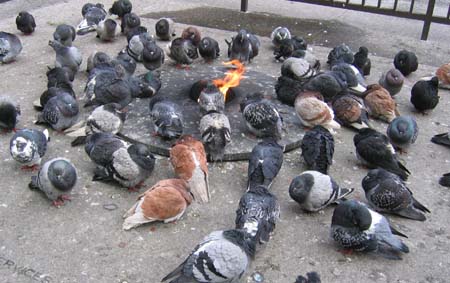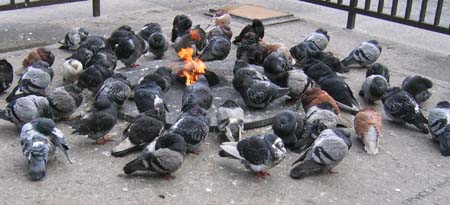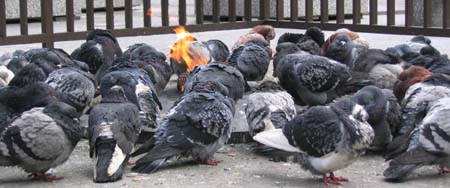Someone stuck a camera in a tree, hooked it up to an encoder, and pointed it at a wild Bald Eagle nest. The cam is live when there’s daylight on the nest in Vancouver, BC; archive footage is shown overnight.
read more | digg story
Pigeon Fanciers In Kabul, Afghanistan
When they were in power, the Taliban banned pigeon fanciers from flying their flocks. Recently, at least six flocks of pigeons may be seen exercising above the dull rooftops of Kabul on a given evening. Read about one pigeon keeper in Griff Witte’s story Pigeons take to the skies over Kabul from The Washington Post.
A Hummingbird Never Forgets?
Hummingbirds have a unique memory “so exact that it’s unique among wildlife.” Researchers monitored wild rufous hummingbirds as they visited eight feeders filled with sugar solution. The feeders were refilled at different times, and the hummingbirds were able to recognize the pattern and visit the feeders at the appropriate time. Read the story Hummingbirds sing a precise food tune on the CBC.
Old Chicago Airport To Become Bird Hospital
Last week it was announced that a part of the former Meigs Field airport terminal building would be converted into a bird hospital. Read the story Bird Hospital To Be Established At Old Meigs Field at NBC Chicago.
Celebrate World Eagle Day This Weekend
This Sunday, March 26, the World Bird Sanctuary in St. Louis, Missouri will celebrate World Eagle Day. The event will include family activities like crafting, nest building, and face painting. Demonstrations with birds will also be on the agenda.
The World Bird Sanctuary is located at 125 Bald Eagle Ridge Road in Valley Park, 25 minutes west of downtown St. Louis. The event takes place 11am to 4pm and admission is free.
Related link: Explore St. Louis Fact Sheet
Happy First Day Of Spring!
Hopefully the coming of spring means warmer weather and sunnier days. In the cold days of winter, however, pigeons in Chicago find warmth at the city’s Eternal Flame monument on Daley Plaza. We took these photos on 29 December 2005.



Florida Man’s Uplifting White ‘Doves’
Don Brumfield, a retired Walt Disney World security manager, has been raising homing pigeons since he was 13 years old. Today, he brings his pigeons, which resemble white doves, to events such as weddings, parties and even funerals to be used as part of the ceremonies. Read Martin E. Comas’ story Bird man of Sorrento part of national trend in the Orlando Sentinel.
The Bald Eagles Of Homer, Alaska
Last month the city council of Homer, Alaska voted to ban a bald eagle feeding program after nearly thirty years. The ban goes into effect on June 1.
The eagles are a chronic problem for the town. The large predators sometimes attack each other over food, and have been accused of stealing small pets from back yards. Some have collided with traffic.
Homer’s “Eagle Lady”, Jean Keene, will be exempt from the ban until 2010. She has been feeding the eagles raw fish every winter for the last 25 years. Back then, five birds would visit. Today, an average of 150 birds come for the feast.
Related Links:
City of Homer
The Bald Eagles of Homer, Alaska
Sources:
Alaska town to bid farewell to troublemaking bald eagles
Symbol of America Is One Town’s Headache
Council gives ‘Eagle Lady’ feeding rights
The Trouble With Foie Gras
Foie gras (pronounced fwah grah), the fattened liver of an overfed duck or goose, is considered one of the great delicacies of French cuisine. It is a luxury product with a meaty, nutty taste and a velvety texture. Unfortunately, the method used for producing the treat is horrible and cruel.
Waterfowl, either geese or ducks, are force fed large amounts of grain by means of a metal pipe forced down the esophagus. The force feeding enlarges the bird’s liver, up to 10 times the normal size. The bird is then slaughtered and the enlarged liver is removed to make foie gras.
The practice of over-feeding birds to produce a fattened, tasty liver, may date back to 2500 B.C. Egypt, where reliefs of the practice have been found on ancient tombs.
Today, 80% of the world’s foie gras is produced in France. Quebec also has a large foie gras industry.
Because birds do not chew and have no gag reflex, they can easily be force fed large amounts of food. In the final stage of feeding, the birds are force fed for 12 to 18 days, two to three times per day. The force feeding causes large amounts of fat to accumulate in the liver, which produces the buttery consistency of foie gras.
The forceful methods used to feed the birds sometimes result in damaged esophagi, which can lead to a slow and painful death. The birds may choke on regurgitated food, or bleed to death. The average (pre-slaughter) mortality rate for birds on foie gras farms is up to 20 times higher than duck farms which do not produce foie gras. Veterinarians have also claimed that a bird carrying an enlarged liver may suffer “unspeakable pain and suffering.” Birds with enlarged livers may also be unable to stand upright or walk.
In late 2003, a consortium of French animal rights groups claimed that the practice of force feeding birds is already illegal under existing animal protection laws of France and the European Union. The EU law states that “reasonable steps (must be taken)… to ensure that … animals are not caused unnecessary pain, suffering or injury.” Foie gras producers affirm that force feeding does not constitute pain or suffering of the ducks and geese. Industry groups and researchers claim that animals even appreciate the feeding method.
One alternative method of producing a similar food suggests the surgical removal of livers from birds which have died of natural causes, and soaking them in mixtures of gelatin, alcohol and buttermilk.
Foie gras is illegal in several jurisdictions. Force feeding is already prohibited in the following countries: Argentina; the Czech Republic; Denmark; Finland; Germany; Ireland; Italy; Luxembourg; Norway; Poland; Sweden; Switzerland; the Netherlands; and the United Kingdom. Israel was the world’s third largest producer of the product when it was banned there in March 2005. Legislation is currently pending in California. Force feeding in that state is slated to become illegal in 2012. The sale of foie gras will also be illegal, if the method of production includes force feeding. Foie gras is currently served in about 300 California restaurants.
Foie gras has been produced in the state of New York at Hudson Valley Foie Gras since 1989. The company distributes the product nationwide. The ASPCA has filed charges against the company in the past for the force-feeding of ducks, but so far the District Attorney involved has not taken action.
Related articles:
Gourmet Cruelty
Stop Force Feeding
Does a Duck Have a Soul?
An ending made in Hollywood for an epic fight over foie gras
Welfare Aspects of the Production of Foie Gras in Ducks and Geese
Sources:
Foie gras
What is Foie Gras?
Debunking The Myths
How Foie Gras Is Produced
California Bans Foie-Gras Force-Feeding
Israel Bans Force-Feeding Geese For Foie-Gras
Pelican Island Wildlife Festival, Florida
This Saturday, March 11, the 14th edition of the Pelican Island Wildlife Festival will take place at Riverview Park in Sebastian, Florida. The festival celebrates the 103nd anniversary of Pelican Island and the National Wildlife Refuge System.
Events at the festival will include:
+ Live wildlife shows
+ 5K run
+ Boat tours of Pelican Island
+ Live music
+ And much more
Sixteen different species of birds breed on Pelican Island. In total thrity species use the island for feeding, roosting or nesting.
Visit the offical website of the festival for more information.



